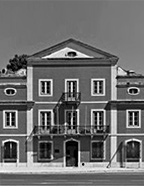

................................
Meanwhile, President António de Vasconcelos had been appointed member of the National Centennial Commission on 11 April. Many requests were also forwarded to the Academy, which was consulted on matters of the most diverse nature (The Banco de Portugal requested instructions on the "issue of banknotes, the design of which is based on people or facts that have contributed preponderantly to the events that shall be commemorated". The request was later fulfilled and communicated in an Official Notice dated 6 July of the same year). In short, the machine was up and running and urgently required capable and hard- working secretarial staff. This request is illustrated in various official notices, as well as in the budgets, which also record the funds needed for the purchase of furniture. Also present in almost every form of contact is the need to find decent headquarters, a goal that neither António de Vasconcelos and his team nor the successive Presidents have yet managed to achieve! But the Academy's greatest activity was undoubtedly its publications. On learning that the President of the Council had approved the proposed editorial programme, in a meeting on 12 August, the Academic Council expressed its delight at this decision, which gave "... the Academy the power to initiate its action with a series of important works, deciding "... to request the collaboration of all the academics, inviting them to produce monographs ...". In accordance with the government's proposal, it was later approved that not only monographs were to be produced, but also collections of sources and iconography relating to the History of Portugal. To begin, Duarte D'armas' Livro das Fortalezas do Reino [Book of the Kingdom’s Fortresses] , the Livro do Armeiro-Mor [Book of the Armorer-Major], and António Godinho's Livro da Nobreza [Book of Nobility] were suggested.
Reading through the correspondence sent and received by the Academy over the course of these months, it is possible to sense the enthusiasm with which these men embraced the task. Numerous proposals were received, and lists were sent to the minister for approval. This is reflected in the budget changes that rapidly made new resources possible. For example, the budget approved for 1938 set aside 60 contos for the launch of publications, but this amount would rise to 150 contos in 1939. In order to coordinate the work, the appointment of an executive committee was proposed and accepted, which was to consist of five members and "... meet without delay...". In the words of the President, "... It is good that the Commission should be empowered to call upon any specialised technician... There are undoubtedly advantages in establishing harmony between this Commission and the other already appointed for the other publications.
